Summary
.) September contest video is ready
.) Chemistry is an experimental science
.) Making diamonds with ultrasound
.) Copper nanoparticle emulsions
.) Graphene emulsions
.) Making an air bell
.) All the stuff
.) New schematic update
September contest video
The contest video for September is up on the project page.
The video quality isn't the best: the camera is crooked, the lighting has dark and light bands (why?), moving objects (my hands) have jagged edges, the dialog has mistakes, and the scenes are poorly spliced.
But it explains the problem (to be solved) to a non-technical audience, and has a good overview of the system and how to build it.
It probably should place more emphasis on what the system can be used for rather than the Haber aspects (mixing, drilling, levitation, etc.). I hope it's clear to the judges that this can be used for more than just exploring Haber.
I'm hoping that the video quality really doesn't matter, as advertised. Other contest project videos seem more polished.
Chemistry is an experimental science
Chemistry is very much an experimental science.
For a clear example, note that chemists had predicted graphene to be impermeable to water. The holes in a carbon hexagon structure are too small to pass water molecules, so graphene should act as a water barrier.
It doesn't.
In fact, not only does water pass through graphene, it acts as if the graphene isn't there. This has many potential applications, not least of which is desalinization...
but my point is that Chemistry often doesn't predict the outcome of an experiment.
It's not that Chemists don't know the underlying principles, it's more a case of not knowing *which* underlying principle will dominate. As the graphene paper shows, it was only after the experiment was performed that chemists went in and re-analyzed the situation, and figured out why graphene was water permeable.
That's good news for us hackers. There's a lot of interesting chemistry waiting to be discovered, and some of it will be accessible if you have an ultrasonic system to play with.
Such as...
Making diamonds with ultrasound
Graphite-to-diamond transformation induced by ultrasound cavitation
Summary: Ultrasonic cavitation of graphite suspended in oil produces diamond grit. Although the researchers used a 1000 watt ultrasonic system, the actual chamber energy density was only 80W/cm^2.
This Hackaday project entry can produce that energy density.
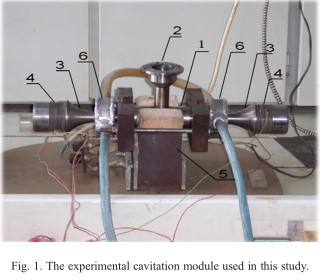
Copper nanoparticle emulsions
Synthesis of copper nanoparticles by two different methods
A recently discovered (2005, I believe) chemical reaction uses copper chloride and ascorbic acid to make copper nanoparticles. Copper chloride is readily available, and ascorbic acid (vitamin C) is available on eBay for pennies.
I've actually tried this, it's trivial. You get a precipitate of finely-divided copper lining the bottom of your flask, and the particle size is determined by the reaction temperature. You can "tune" the reaction to generate whichever size of particle you need.
This would make a conducting ink, except that copper forms a surface oxide that's non-conductive. The nanoparticles are small and have such enormous surface area that the oxides reduce conduction and the result has little or no conductivity. Pressing the particles - as with a spoon - mashes them together and reduces the surface area. You can make PCB traces this way.
See "Copper Nanoparticles for Printed Electronics: Routes Towards Achieving Oxidation Stability" for more info.
An ultrasonic system can make an oil/water emulsion that will last for days.
Would an oil emulsion of copper nanoparticles have any use?
Graphene emulsions
On the subject of emulsions, note that graphene suspensions can be made with a blender and soap.
Would this process benefit from sonification?
Would an emulsion of oil and graphene have useful properties?
Making an air bell
The gas collection system was the last piece I needed for the project - an "air bell".
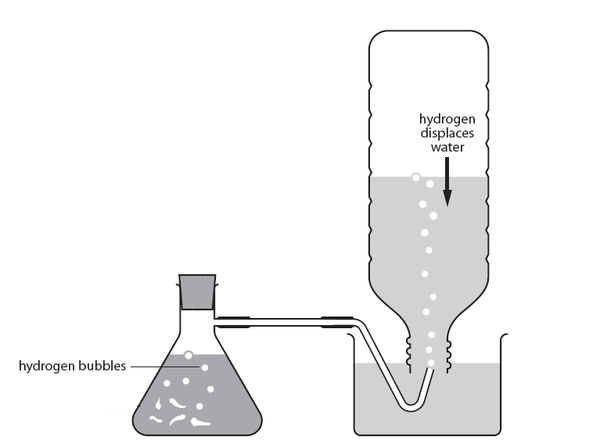
Cut the bottom out of a 2-liter bottle and hang it inside a glass flower vase from an art supply house. Weigh it down, drill a hole and hot-glue some PVC tubing into the cap.
Easy peasy!
To calibrate, I hung the bell upside down (cap down) and stuck a piece of tape along the sides. I then weighed out 500g of water using a scale, added this to the bell, and marked the water level (accounting for meniscus). I repeated this procedure until the bottle was full.
I then tested by filling the bottle to one of the marks and weighing the result.
It's accurate to within 1%, which is good enough for my purposes.
I snake a a tube from the Nitrogen generator through the bottom of the bell and add gas until the water level reaches the right level, then I do the same with 3x more volume of Hydrogen.
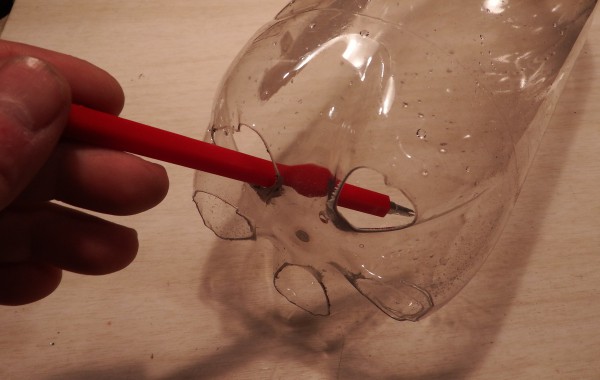
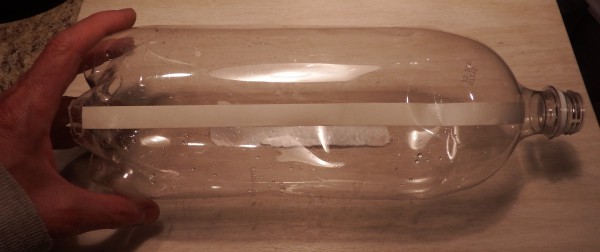
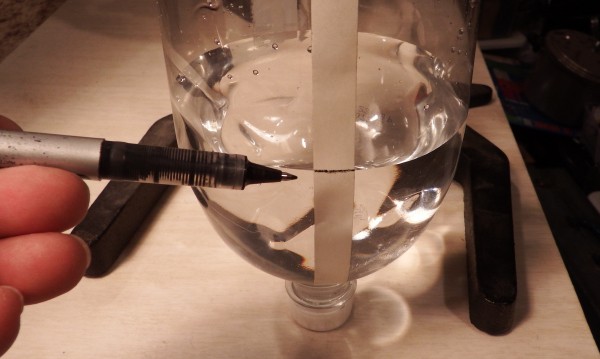
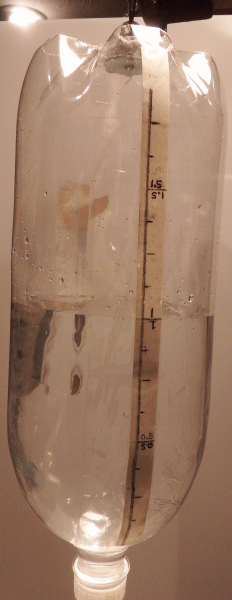
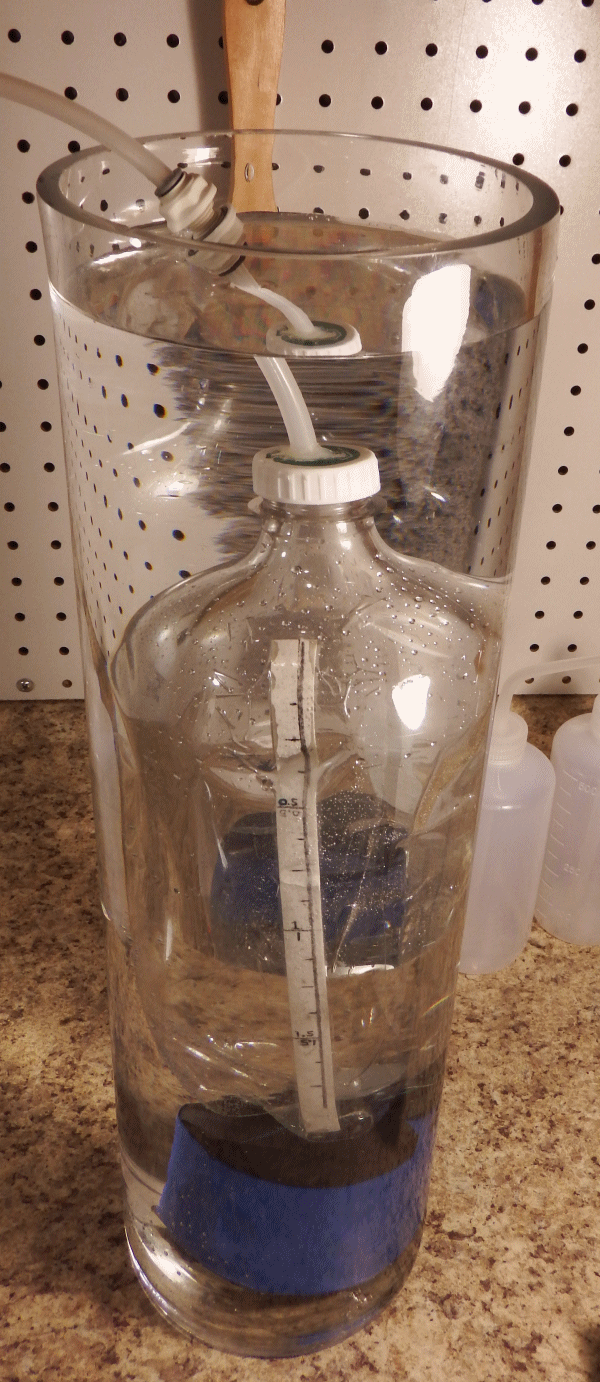
All the stuff
I'll be making a big data dump into the GitHub project wiki and the build instructions on Hackaday.io, so I went 'kinda crazy with taking photographs.
Here's all the project accessories. This doesn't include the air bell, the drill press stand (transducer holder), or the driver board.

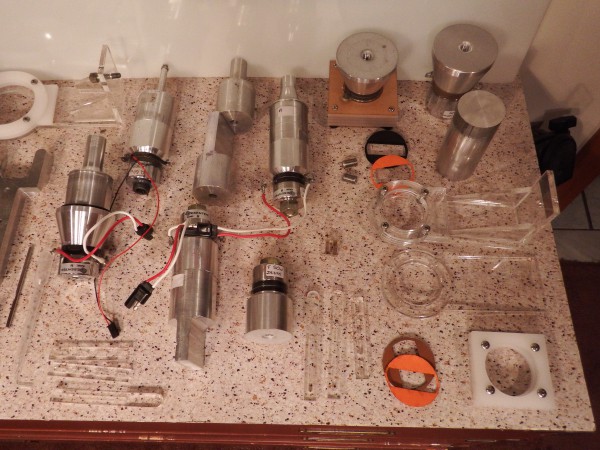
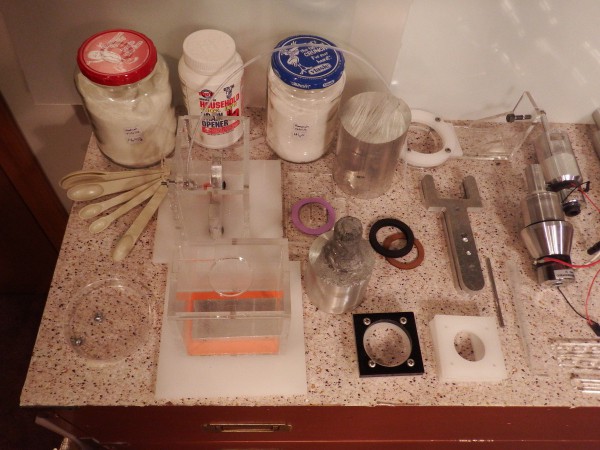
New schematic
The new circuit is working in prototype, has been schematically captured, and I am having SO MUCH trouble with Kicad!
After many hours of swearing and tweaking, everything is finally working, and it only takes me a half an hour to make small changes to the schematic.
Now I know why people spend thousands of dollars on Altium. Sheesh!
Anyway, the new circuit is up in the project description. It's the original circuit, except using an AD9833 for frequency control instead of digital pots.
I've made 4 improvements in the schematic that are not on the prototype board, but they're relatively safe and I think they'll work out of the box, or at least require minimal debugging.
The plan is to have the PCB laid out and order boards from OSH Park in the next week, which should arrive in 2 weeks.
Here's an example Kicad trouble: the diode in the schematic points away from ground, but on the PCB it points *towards* ground. I have no idea why this is, and I have no idea how to fix it. And yes, I've made and loaded the netlist several times. It's something in the program, not the schematic!


 Peter Walsh
Peter Walsh
Discussions
Become a Hackaday.io Member
Create an account to leave a comment. Already have an account? Log In.
Really nice video! I also appreciate all the other uses you're finding/suggesting for your apparatus.
I've had problems with light banding on my videos as well - it's because the scene is lit with fluorescent tubes, and I've never found a way to mitigate it...
Are you sure? yes | no
Excellent video! I like the cut paper presentation - something more personal about it.
Are you sure? yes | no